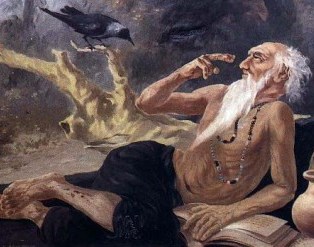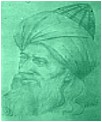Punjab - Literature - Sufi Saints
Punjab is not only great but is also vast and varied. Punjab, the land of five rivers, is very fortunate in having developed and cherished, since centuries, a long and glorious tradition of a composite culture. It seems to have been evolved and enriched by a galaxy of God-intoxicated men who belonged to various faiths and creeds, such as Hindu saints, Sikh Gurus and Sufi fakirs. Their mystical songs, in particular, are the pride of the whole Punjab and form a common and invaluable heritage of all Punjab's.
The lyrical effusions of those blessed men, incidentally, gave birth to a distinct stream of the poetry of this land, called Sufi Kavya-Dhara, which inherits a rich and long literary tradition. The content and form, scope and standard as well as the flow of masterly beauty of Farid Bani, which has come down to us through the grace of Guru Granth Sahib, is a proof of this 'Dhara' having been in vogue about seven centuries ago.
It was developed by Shah Hussain during the sixteenth century and raised to its pinnacle by Bulleh Shah during the eighteenth century. Its downfall began after Hashim Shah during the second half of the nineteenth century. It was, however, kept flowing by Maulvi Ghulam Rasul, Syed Miran Shah and Khwaja Ghulam Farid during the next few decades.
Most of all major poets of Punjab have, more or less, been influenced by it. Its influence on the Non-Muslim mystic poets of the first half of the twentieth century viz. Sant Rein, Sadhu Daya Singh, Paul Singh Arif, Man Singh Kalidas and Kishan Singh Arif is quite evident. Even the poets of the modern period, including Bhai Vir Singh (1872-1957), the father of modern Punjabi literature, have also imbibed its impact.
Sheikh Farid-ud-din , (1173-1265) was the first Sufi poet who "sang of his insatiable hunger for the love of the Lord in works of immortal beauty".
Farid's message had a wide humanitarian base and a broad human approach. In an age marked by the great brutality, he brought the touch of humanity and fellow feeling to all.
 |
 |
Farid was also the first poet of Punjab and Punjabi who used the symbol of human relationship between wife and husband to express his longings for union with the Divine.
The kafis (lyrics) of Shah Husain (1538-1599), the popular romantic Sufi saint of Lahore added to Sufi poetry its peculiar element of masti (rapture) and introduced enraptured dancing and passionate singing.
Hussain was also the first Sufi poet of Punjabi who adopted the popular measure of Kafi to express his mystic ideas. The credit of introducing the element of the popular love-legends of Punjab (Heer Ranjha and Sohni Mahiwal) to Sufi Verse and utilizing their persons, places, motifs and incidents as images, metaphors and allegories etc. also goes to him.

Sultan Bahu (1629-1691), one of the greatest mystics of India, who belonged to district Jhang, adopted the verse-form of Shiarfi (arostic) for the expression of his sentiments, ending every line of his verse with a lyrical tone of exquisite charm, pronounced as hoo. It was he who, preferring 'Ishq' (love) not only to 'Aqal' (wisdom) but also to 'Iman" (faith).

Syed Bulleh Shah (1680-1758), was the most famous Sufi poet of Punjab. Bullah asserted his commitment forcefully and longed for his visit so feelingly, as under :
You are just a herdsman for the folk, People call you by the name of Ranjha.
But for me you are my religion and my faith. O come and do enter my courtyard.
His kasab nama broke a new ground by describing the process of wearing cloth for expressing his Sufistic ideas and beliefs. In his Siharfi, Fard did not spare even the ever hostile Ulama (doctors of law and religion) by expressing their hypocrisy and observing that "it hardly avails if an ass is loaded with books".
His kasab nama broke a new ground by describing the process of wearing cloth for expressing his Sufistic ideas and beliefs. In his Siharfi, Fard did not spare even the ever hostile Ulama (doctors of law and religion) by expressing their hypocrisy and observing that "it hardly avails if an ass is loaded with books". Punjabi Sufi Poetry got a new fillips with the advent of Syed Hashim Shah (1735-1843), a highly learned, prolific and multilingual writer who flourished during the Sikh supremacy in Punjab and who has been mentioned in terms of esteem even by eminent Western scholars.

In Punjabi, he versified the popular love-tragedies of Punjab to describe and acclaim the 'Kamal Ishq' (perfect love) of their heroes and heroines (viz. Sassi & Punnu, Heer & Ranjha, Sohni & Mahiwal, Shirin & Farhad).
The Sufi poets of Punjab, in the similar way, utilized only those poetical modes and verse-forms, for the expression of their emotions, experiences and yearnings which were quite popular and familiar to the people of the land. They composed Shloks, Dohe, Shabads, Kafis, Khayals, Baramahs, Athwaras and Sinarfis, etc.
As a matter of fact, the Sufi saints and poets of Punjab contributed so much and so well not only to the linguistic, literary and cultural heritages of Punjab, they also identified themselves, intrinsically, with its land and people.